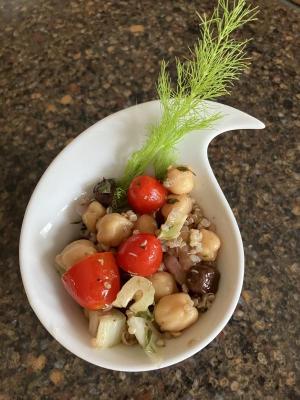Not sure if it’s because of all the recent rain or if I’m just craving fiber-rich food, but I’ve been eating a number of bean dishes recently. And, of course that sent me down the proverbial rabbit hole to learn about the similarities and differences among the various foods that are referred to as legumes, beans and pulses.
At the highest level botanically, legumes are the overall classification for these foods. Legumes are distinguished by nitrogen-fixing bacteria in structures known as root nodules which give them the unique ability to replace nitrogen in the soil. Consider the name for this plant family as an umbrella term for the thousands of varieties of beans, peas, and pulses grown around the world.
Pulses are the dried seeds of legume plants. Among the different types are dried beans, dried peas, chickpeas and lentils. Their name comes from the latin puls meaning seeds that can be made into a thick soup. Other legumes that are not pulses include soybeans, peanuts, fresh peas and fresh beans. Fresh peas are round and typically green in color, very different from their dried split pea cousins.
Beans have been found in global culinary traditions for centuries as a reliable source of protein. Some of the more familiar types in this group are: pinto, kidney, great northern, lima, mung, white, cannellini, black, adzuki, and black-eyed peas. These can be found for sale in dry form as well as sometimes frozen and often in cans. If you have the time, your healthiest option is to start with the uncooked beans, as canning often adds salt and preservatives.
To prepare the beans for a recipe, they first need to be soaked overnight. During this step they will expand in size, so make sure you cover them with plenty of water. The next step is to simmer the beans to soften them to the desired degree, depending upon the recipe. For example, if you are using chickpeas (garbanzo beans) for hummus, you want them quite soft, versus a stew or salad where you’d like them firmer.
On the topic of chickpeas and garbanzo beans, they are the same thing. These small, round, beige-colored legumes are a staple in many cultures around the world. They are a great source of protein, fiber, and other essential nutrients. Chickpea is the term used commonly in the United States and comes from the Latin cicer from its botanical name. In Spain and Latin America, you will hear them called garbanzo beans from their Spanish name.
For the recipe in the photo, I turned to Diane Kochilas, a Greek chef who is always finding healthy ways to use simple ingredients. Revithosalata is what she called this hearty and delicious chickpea salad. Made with onion, fennel, chickpeas, and quinoa, it's the perfect combination of healthy and tasty, packed with plenty of plant-based protein.
The other recipe using chickpeas comes from Tori Avey’s food blog. For a vegan take on egg salad, she mashes avocado and chickpeas together to top a slice of crusty bread. Although I advocate using dried beans, sometimes convenience wins the day, which is why both recipes call for a can of chickpeas - just be sure to drain them thoroughly.
Chickpea & Quinoa Salad*
1 C quinoa
2 bay leaves
1 T olive oil
1 diced red onion
1 diced fennel bulb
1 minced garlic clove
15 halved cherry tomatoes
15-oz can chickpeas, drained
1/2 C pitted, chopped kalamata olives
1 T snipped fennel fronds
1 T chopped oregano
1 T chopped parsley
3 T olive oil
2 T white Balsamic vinegar
juice and zest of 1 lemon
salt and pepper, to taste
Place quinoa in a small saucepan along with enough water to cover by 2 inches. Add bay leaves and bring to a simmer; cover and cook for 15 minutes. Drain any excess water and transfer quinoa to a serving bowl; discard bay leaves. Heat olive oil in a skillet over medium and sauté the onion, fennel, and garlic until softened, about 5 minutes. Transfer mixture to the serving bowl. Add tomatoes, chickpeas, and olives to the bowl along with the herbs. Toss gently to combine. Whisk together oil, vinegar, juice, and lemon zest; season to taste with salt and pepper. Pour dressing over salad and toss to combine. Yield: 6 servings. *Adapted from My Greek Table by Diane Kochilas.
Chickpea & Avocado Spread*
15-oz can of chickpeas, drained
1 ripe avocado
juice of 1 lemon
1 T snipped dill
salt and pepper, to taste
Place the drained chickpeas in a mixing bowl. Peel and seed the avocado. Cut the flesh into chunks and add to the bowl. Using a potato masher, combine the ingredients into a thick paste, leaving the texture as chunky as desired. Stir in lemon juice and dill; season to taste with salt and pepper. Serve with crackers or slices of whole grain bread. Yield: 2 servings. *Adapted from Tori Avey.
























































